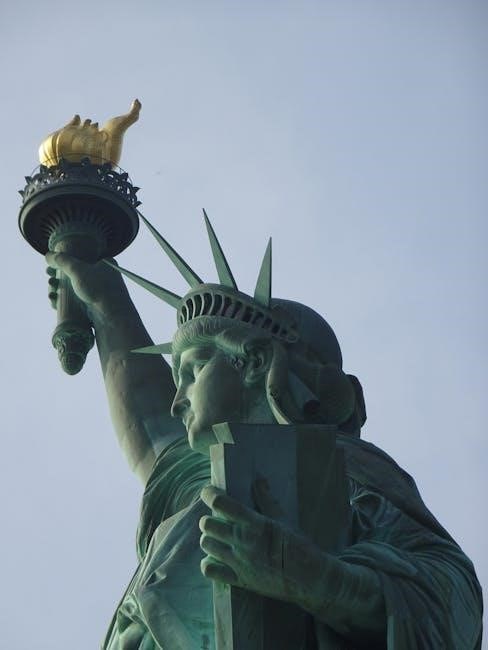The American President Movie Guide Answers offers a comprehensive resource for analyzing the film’s themes, characters, and political context. It includes structured questions, an answer key, and activities designed to engage students and educators, bridging entertainment and education for a deeper understanding of leadership and governance.
Purpose of the Guide
This guide is designed to provide a comprehensive understanding of The American President movie, offering structured questions and analysis to enhance critical thinking. It serves as an educational tool for students and educators, exploring themes of leadership, politics, and romance. The guide includes detailed answers to facilitate discussion and deepen comprehension of the film’s relevance. By focusing on key scenes and character development, it encourages learners to connect cinematic elements with real-world political and social issues. This resource is ideal for classroom use, promoting engagement and reflection on the complexities of presidential leadership and governance.
Overview of the Movie and Its Relevance
The American President is a 1995 film that masterfully blends political drama with romantic comedy, offering a compelling portrayal of life in the White House. Directed by Rob Reiner, the movie follows President Andrew Shepherd as he navigates the challenges of leadership, romance, and political satire. Its relevance lies in its timeless commentary on presidential responsibilities, media influence, and the balance between personal and professional life. The film remains a powerful educational tool, providing insights into U.S. politics and leadership dynamics, making it a valuable resource for critical analysis and discussion in both academic and general audiences.

Context of the Movie “The American President”
The American President, released in 1995 and directed by Rob Reiner, uniquely blends political drama with romantic comedy, portraying the challenges of a U.S. President’s dual life.
Release Year and Director
The American President was released in 1995, directed by the renowned filmmaker Rob Reiner, known for his nuanced storytelling and ability to blend genres seamlessly. The film, written by Aaron Sorkin, captures the complexities of political life with witty dialogue and emotional depth. Reiner’s direction masterfully balances humor and drama, creating a relatable yet idealized portrayal of leadership. The movie’s release coincided with a heightened interest in political narratives, making it a significant cinematic contribution of the mid-1990s. Its success can be attributed to Reiner’s vision and Sorkin’s sharp, insightful script.
Blend of Political Drama and Romantic Comedy
The American President masterfully combines the intensity of political drama with the charm of romantic comedy, creating a compelling narrative. While the film delves into the complexities of governance and policy-making, it also explores the blossoming romance between President Shepherd and Sydney Wade. The witty dialogue and comedic moments, often arising from the challenges of balancing power and personal life, add lightness to the otherwise serious political backdrop. This unique blend captivates audiences, offering both intellectual engagement and emotional connection, making it a standout in both genres.
Key Themes: Leadership, Romance, and Satire
The American President explores three core themes: leadership, romance, and satire. The film examines the challenges of presidential leadership, highlighting the tension between personal convictions and political pragmatism. Romance blossoms between Shepherd and Sydney Wade, adding an emotional depth to the story. Satire is woven throughout, critiquing media sensationalism and political tactics. These themes intertwine to create a nuanced portrayal of power, love, and the complexities of public life, offering both entertainment and commentary on the realities of governance and human connection.

Plot Summary and Key Elements
The American President follows President Andrew Shepherd as he navigates political challenges, romance with lobbyist Sydney Wade, and passing a crime bill amidst media scrutiny and personal struggles.
President Andrew Shepherd and His Challenges
President Andrew Shepherd, a widowed leader, faces declining approval ratings and a tough re-election campaign. He struggles to pass a controversial crime bill while balancing his personal life. As a single father to his daughter Lucy, Shepherd navigates the pressures of parenthood alongside the demands of the presidency. His leadership is tested as he confronts partisan attacks, media scrutiny, and the complexities of romance with lobbyist Sydney Wade. The film portrays his efforts to maintain integrity, pushing progressive policies while adapting to political realities and personal vulnerabilities.
The Romance with Sydney Ellen Wade
The romance between President Andrew Shepherd and Sydney Ellen Wade is a central subplot, blending political intrigue with personal connection. Sydney, a passionate environmental lobbyist, captivates Shepherd with her intelligence and dedication. Their relationship evolves from professional meetings to deeper emotional bonds, despite the challenges of media scrutiny and political fallout. The romance humanizes Shepherd, showcasing his vulnerability and desire for companionship, while highlighting the complexities of balancing public duty with private feelings. This dynamic adds emotional depth to the film, exploring love’s power amidst high-stakes politics.
Political Struggles and the Crime Bill

The crime bill is a central political battle in the film, showcasing President Shepherd’s leadership challenges. Despite its importance, the bill faces fierce opposition, with critics focusing on mandatory minimum sentences and gun control provisions. Shepherd’s administration struggles to maintain bipartisan support, while political rivals exploit the debate for personal gain. The president must decide whether to compromise or stand firm on his principles. This storyline highlights the complexities of political negotiation and the media’s role in shaping public perception, ultimately testing Shepherd’s resolve and leadership abilities amidst mounting pressure.

Main Characters in the Movie
The film features President Andrew Shepherd, a widowed leader balancing politics and romance, alongside Sydney Wade, a passionate lobbyist, and loyal staff members shaping the story.
President Andrew Shepherd
President Andrew Shepherd, portrayed by Michael Douglas, is a widowed U.S. President balancing leadership with personal life. His compassionate yet firm approach to governance highlights his commitment to public service. As a single father to his daughter Lucy, Shepherd’s personal struggles add depth to his character. His idealistic vision for America often clashes with political realities, particularly in his efforts to pass a crime bill. Shepherd’s journey explores the weight of presidential responsibilities and the challenges of maintaining personal integrity in a demanding political landscape.

Sydney Ellen Wade
Sydney Ellen Wade, played by Annette Bening, is a passionate environmental lobbyist who captivates President Shepherd with her intelligence and determination. Her professional demeanor and personal charm create a dynamic relationship with the President, blending political tension with romantic chemistry. As an advocate for climate change legislation, Sydney challenges Shepherd’s administration, pushing him to reconsider his priorities. Her character represents a strong, independent woman navigating the complexities of Washington politics while influencing Shepherd’s personal and professional decisions, adding depth to the story’s exploration of power and romance.
Key Staff Members: AJ, Robin, and Leon
The President’s staff plays a pivotal role in the film, with AJ MacInerney, Chief of Staff, showcasing sharp wit and unwavering loyalty. Robin McCall, the Press Secretary, skillfully navigates media challenges, while Leon Kodak, the young communications director, brings fresh perspectives. Together, they support Shepherd in balancing political crises and personal life, exemplifying the dedication and camaraderie of a presidential team. Their interactions highlight the behind-the-scenes efforts of White House staff, emphasizing their crucial roles in shaping policy and public image.

Themes and Messages in the Movie
The film explores leadership, romance, and satire, highlighting universal themes like integrity, public versus private life, and the influence of love on presidential decision-making.
Leadership and Presidential Responsibilities
The movie portrays President Shepherd as a leader grappling with immense responsibilities, balancing policy decisions with personal ethics. His commitment to public service is tested by political pressures, highlighting the weight of presidential duty; The film emphasizes the importance of integrity, vision, and empathy in leadership, as Shepherd navigates complex issues like the crime bill. His struggle to maintain moral grounding amidst partisan chaos underscores the challenges of modern governance. The portrayal reflects the dual role of a president as both a political figure and a human being, illustrating the toll of leadership on personal life.
Political Satire and Media Influence
The film uses satire to critique the political machine and media frenzy surrounding the presidency. President Shepherd’s personal life becomes a media spectacle, reflecting how politicians are scrutinized. The movie highlights how media narratives can shape public opinion and influence policy debates. Satirical elements mock the superficiality of political spin and the lengths to which politicians go to maintain their public image. This commentary remains relevant, offering insight into the enduring challenges of balancing governance with media-driven perceptions.

Balancing Personal and Professional Life
In “The American President,” President Shepherd faces the challenge of balancing his role as a leader with his personal life. As a widower raising his daughter, he struggles to maintain a sense of normalcy amidst the demands of the presidency. His relationship with Sydney Wade adds emotional depth, showcasing the tension between public duty and private desires. The film highlights the sacrifices inherent in leadership, as Shepherd navigates love, parenthood, and political responsibilities. This theme resonates universally, illustrating the difficulty of separating personal and professional identities in high-pressure roles.

Educational Resources and Movie Guide
This section provides structured questions, an answer key, and grading support for educators. It also offers historical context to enhance learning and critical analysis of the film.
Structured Questions for Critical Thinking
These questions encourage analysis of the film’s themes, characters, and political dynamics. Examples include: How does President Shepherd balance leadership and personal life? What role does Sydney Wade play in challenging his priorities? How does the crime bill reflect broader political tensions? What commentary does the film offer on media influence in politics? How does the romance between Shepherd and Wade impact his public image? What lessons can be drawn from the film about leadership and compromise? These questions help students engage deeply with the movie’s content and themes.
Answer Key and Grading Support
The guide includes a comprehensive answer key to help educators assess student responses; It provides clear, concise answers to the structured questions, ensuring consistency in grading. Additional grading support, such as rubrics and assessment criteria, is offered to evaluate critical thinking and understanding. The answer key also highlights key themes, character motivations, and historical context to deepen comprehension. This resource enables educators to efficiently manage evaluations while fostering meaningful discussions about the movie’s political and social implications.
Historical and Real-World Connections
The movie reflects the political climate of the 1990s, mirroring real-world issues like gun control and environmental policies. The fictional crime bill debate parallels actual legislative battles, showcasing the challenges of balancing public opinion and political agendas. The portrayal of media influence and public perception aligns with historical accounts of presidential struggles, such as the Clinton administration’s experiences. These connections provide a realistic backdrop, making the film a valuable tool for understanding the complexities of U.S. politics and leadership during this era.

Cultural and Historical Significance
The film captures the spirit of 1990s politics, blending drama and comedy to reflect societal values. Its portrayal of leadership and romance resonates with real-life presidential experiences, offering timeless commentary on public service and personal sacrifice. The movie’s themes of balancing power and emotion continue to inspire, making it a relevant reflection of American political culture and its evolving expectations of leaders.
Reflection of 1990s Political Climate
The American President mirrors the political atmosphere of the 1990s, capturing the era’s optimism and challenges. The film reflects the decade’s focus on media scrutiny of leaders, the rise of political polarization, and the blending of personal and public life. It also touches on key issues of the time, such as gun control and environmental policy, while portraying a president aiming to balance idealism with political pragmatism. The movie’s depiction of a single president navigating public and private pressures resonates with the 1990s’ evolving views on leadership and accountability.
Comparison to Real-Life Presidential Experiences
The American President draws parallels to real-life presidential experiences, particularly in its portrayal of balancing personal and political life. President Shepherd’s challenges echo those of real presidents, such as the scrutiny of personal relationships and the strain of leadership. The film’s focus on a crime bill mirrors real legislative battles, while the character’s idealism and pragmatism reflect the complexities faced by leaders like Bill Clinton. The movie’s depiction of media intrusion and public expectations aligns with the realities of modern presidency, offering a relatable yet fictionalized view of leadership struggles.
Timeless Commentary on Leadership
The American President provides a timeless commentary on leadership, exploring the tension between idealism and pragmatism. President Shepherd’s journey reflects universal leadership challenges, such as making tough decisions, balancing personal values with political realities, and maintaining integrity under scrutiny. The film highlights the emotional toll of leadership, emphasizing the importance of empathy, courage, and resilience. Its portrayal of a leader navigating complex dilemmas resonates across generations, offering insights into the human side of leadership that remain relevant today. The movie underscores the enduring principles of leadership, making it a compelling study of both politics and humanity.
The movie guide provides a comprehensive analysis of The American President, blending political drama and romance while exploring themes of leadership and personal sacrifice, making it an excellent educational resource.
Impact of the Movie as a Learning Tool
The American President serves as an engaging educational resource, blending entertainment with insights into governance, leadership, and policy-making. Its portrayal of the presidency, political negotiations, and personal sacrifices provides students with a relatable perspective on U.S. politics. The film’s mix of drama and humor makes complex concepts accessible, fostering discussions on ethics, compromise, and public service. The accompanying movie guide enhances its educational value with structured questions, encouraging critical thinking and analysis of real-world political scenarios, making it a valuable tool for civics, history, and government studies.
Final Thoughts on Themes and Relevance
The American President masterfully combines compelling storytelling with timeless themes, offering insights into leadership, romance, and political satire. Its exploration of presidential responsibilities, personal sacrifice, and the complexities of governance remains highly relevant. The film’s ability to balance humor with serious issues makes it a relatable and engaging tool for understanding the challenges of leadership. Its themes of integrity, compromise, and public service continue to resonate, providing a valuable perspective for students and audiences alike on the realities of political life and the human side of power.
